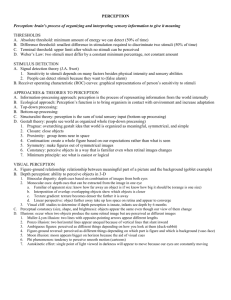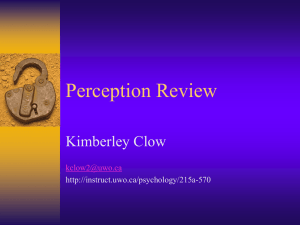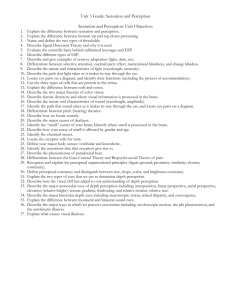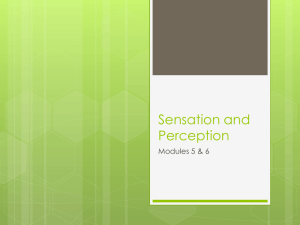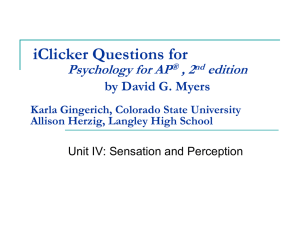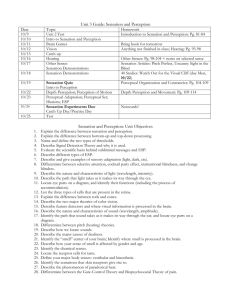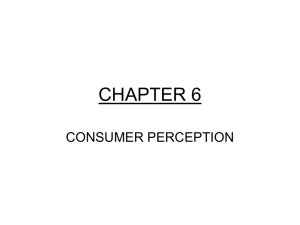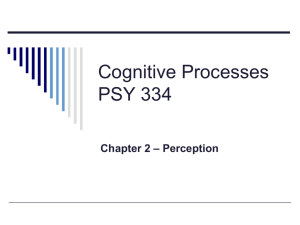Sensation & Perception
advertisement
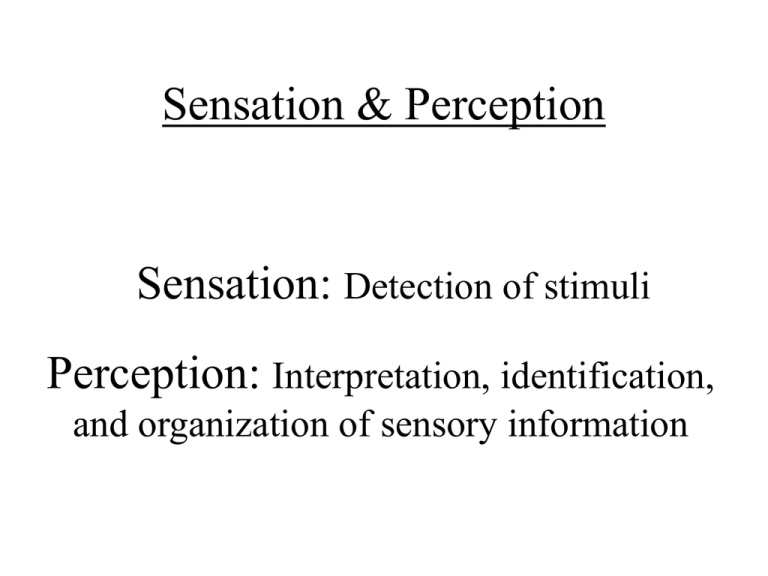
Sensation & Perception Sensation: Detection of stimuli Perception: Interpretation, identification, and organization of sensory information Sensation: Detection of stimuli The Senses Vision Hearing Touch Taste Smell Balance Kinaethesia Proprioception Light Sound waves Pressure, temperature Chemicals Chemicals Gravity Movement Limb position Sensation Bottom-Up Processing analysis that begins with the sense receptors and works up to the brain’s integration of sensory information reflects physical stimuli veridically (accurately) • Absolute threshold - The minimum amount of energy our senses can consciously detect 50% of the time. – – – – – Vision – candle flame at 30 miles Hearing – ticking watch at 20 feet Taste – 1 tsp sugar in 1 gal water Smell – 1 drop perfume through 3 rooms Touch – bee wing falling on face at 1 cm Sensation - Thresholds Difference Threshold Also called “just noticeable difference” or JND the smallest difference between two stimuli that is detectable 50 percent of the time Smallest detectable difference between two stimuli Adaptation & Habituation Sensory adaptation - tendency of sensory receptors to fatigue and stop responding to an unchanging stimulus. This is a physical, bottom-up process Habituation Habituation - tendency of the brain to stop noticing constant, unchanging information. Example – your clothing, fan noise, perfume! Psychophysics study of the relationship between physical characteristics of stimuli and our psychological experience of them Light- brightness Sound- volume Pressure- weight Taste- sweetness Perception 1. Perceptual cues are used 2. Perception is active, constructive 3. Perceptual interpretations can be wrong (illusions) 4. Perception is affected by experience Perception Top-Down Processing information processing guided by higher-level mental processes when we construct perceptions by drawing on our experience and expectations Often imposes a meaning that does not exist in the physical stimulus (not veridical) Top Down Processing • Aoccdrnig to a rscheearch at Cmabrigde Uinervtisy, it deosn't mttaer in waht oredr the ltteers in a wrod are, the olny iprmoetnt tihng is taht the frist and lsat ltteer be at the rghit pclae. The rset can be a total mses and you can sitll raed it wouthit porbelm. Tihs is bcuseae the huamn mnid deos not raed ervey lteter by istlef, but the wrod as a wlohe. • Amzanig huh? Perceptual Organization • Top- down process (individualized by experience) • how your brain makes sense of the world, which includes “hiding” from you certain changes in stimuli so that the stimuli continue to appear constant to you Gestalt Principles of Perception Perception of Depth • Images on the retina are 2-D • How do we perceive 3-D (depth)? • CUE approach – we learn the connection between cues and depth through experience, yielding 3-D perceptions Binocular Cues • Binocular cues - cues for perceiving depth based on both eyes. 1.retinal disparity images from the two eyes differ closer the object, the larger the disparity 2. convergence neuromuscular cue two eyes move inward (converge) more as objects get nearer Monocular Cues • Monocular cues (pictorial depth cues) – cues for perceiving depth based on one eye only. 1. 2. 3. 4. 5. Linear perspective Relative size Interposition (overlap) Texture gradient Motion parallax Menu
